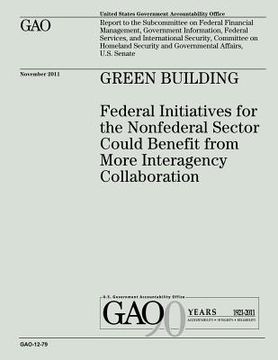Green Building: Federal Initiatives for the Nonfederal Sector Could Benefit from More Interagency Collaboration (en Inglés)
Reseña del libro "Green Building: Federal Initiatives for the Nonfederal Sector Could Benefit from More Interagency Collaboration (en Inglés)"
Economic, environmental, and health concerns have spurred interest in "green building"--construction and maintenance practices designed to make efficient use of resources, reduce environmental problems, and provide long-term financial and health benefits. Federal laws and executive orders direct agencies to meet green building standards in federal buildings and to foster green building in the nonfederal sector; the latter includes private, state, local, and tribal entities and accounts for the majority of the nation's buildings. GAO was asked to (1) identify current initiatives by federal agencies to foster green building in the nonfederal sector and (2) determine what is known about the results of these initiatives. As part of the review, GAO sent questionnaires to the 11 agencies implementing the initiatives identified, including the Departments of Energy (DOE) and Housing and Urban Development (HUD) and the Environmental Protection Agency (EPA); examined agency documents; and spoke with agency officials. GAO did not report funding data because officials stated that agencies do not track many green building funds separately. GAO identified 94 federal initiatives--implemented by 11 agencies--that foster green building in the nonfederal sector. About two-thirds of these initiatives are implemented by HUD (29 initiatives), EPA (18), and DOE (17). According to GAO's analysis of agency questionnaire responses, the initiatives vary in how they foster green building in the following ways: (1) Elements fostered. All initiatives foster at least one of six green building elements GAO identified. Three-quarters foster more than one element, and 21 initiatives across 7 agencies foster all six elements. (2) Direct or indirect fostering. Over two-thirds (64) of the initiatives foster green building directly, and the rest foster green building as part of a broader effort that is focused not primarily on green building but on other purposes, such as expanding the supply of affordable housing for low-income elderly. (3) Type of assistance. The initiatives provide multiple types of assistance, mostly through grants (47 initiatives) and technical assistance (45). (4) Recipients expected to benefit. The direct beneficiaries identified by agencies range from individual property owners and renters to state governments. About one-third of the initiatives have green building goals and performance measures; however, the overall results of most initiatives and their related investments are unknown. For example, according to HUD officials, to measure the results of the Green Retrofit Program for Multifamily Housing, HUD analyzes energy consumption data before and after retrofitting properties. Other agency officials reported various reasons for not having goals and measures, such as challenges in gathering reliable performance data. GAO identified some instances in which agencies have begun to collaborate to assess results but did not identify government wide collaboration on initiatives for the nonfederal sector. As GAO has reported, agencies and programs working collaboratively can often achieve more public value than when they work in isolation. Agencies with green building initiatives for the nonfederal sector may be missing opportunities to, among other things, reach agreement on government wide goals and measures for assessing the overall progress of their green building efforts. GAO recommends that DOE, HUD, and EPA lead an effort to collaborate with other agencies on assessing the results of federal green building initiatives for the nonfederal sector. DOE, HUD, and EPA generally agreed with the recommendation, and HUD and other agencies provided technical clarifications, which GAO incorporated into the report as appropriate.

